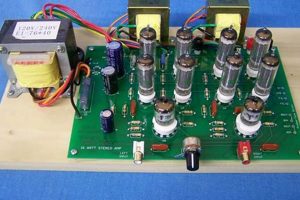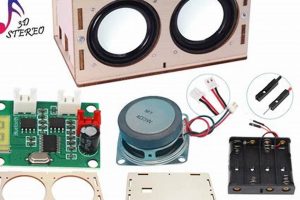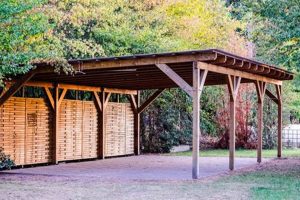These packaged sets contain the necessary components for individuals to apply spray foam insulation themselves, rather than hiring a professional contractor. These typically include a dispensing gun, chemical tanks or canisters containing the foam components, and instructions for proper application. A common example involves sealing air leaks in attics or crawl spaces to improve energy efficiency.
Self-application of insulating foam offers several advantages, including potential cost savings compared to professional installation and the flexibility to address insulation needs on a schedule determined by the homeowner. Historically, insulation projects were often relegated to skilled tradespeople; however, readily available materials and equipment have enabled wider adoption of do-it-yourself methods. Properly executed foam insulation can significantly reduce energy consumption, leading to lower utility bills and a more comfortable living environment.
The subsequent sections will delve into the different types of these solutions available, essential safety precautions, the application process, and factors to consider when determining if this approach is suitable for a specific project. Considerations such as R-value, appropriate applications and ventilation are crucial factors to be investigated.
Application Recommendations
Effective utilization of pre-packaged insulation materials requires careful planning and execution. The following recommendations enhance project success and mitigate potential risks.
Tip 1: Surface Preparation is Crucial. Ensure surfaces are clean, dry, and free of loose debris. Adhesion failures often stem from inadequate surface preparation. For example, applying the foam to a dusty attic rafter compromises the bond.
Tip 2: Temperature Considerations are Paramount. Adhere strictly to the manufacturer’s recommended temperature range for both the environment and the components. Applying the foam in temperatures outside the specified range can negatively impact expansion, adhesion, and curing properties.
Tip 3: Ventilation is Essential. Adequate ventilation is critical during and after application to dissipate fumes and facilitate proper curing. Confined spaces, such as closed crawl spaces, require mechanical ventilation to ensure a safe working environment.
Tip 4: Employ Thin, Multiple Coats. Applying several thin layers, allowing each to cure partially before applying the next, yields better results than a single thick layer. This approach minimizes the risk of sagging, incomplete curing, and excessive expansion.
Tip 5: Prioritize Safety Equipment. Full protective gear, including a respirator, eye protection, gloves, and protective clothing, is non-negotiable. The chemicals involved pose potential health risks through inhalation and skin contact.
Tip 6: Practice Proper Dispensing Techniques. Maintain a consistent distance and angle from the surface during application to ensure even coverage. Jerky movements or inconsistent dispensing rates can lead to uneven insulation and wasted material.
Tip 7: Monitor Expansion Rates. Observe the foam’s expansion rate to avoid overfilling cavities or creating unwanted pressure against walls or ceilings. Excessive expansion can damage surrounding structures.
These guidelines, when followed diligently, contribute to a professionally finished result and maximize the long-term benefits of the insulation.
The next section addresses common problems encountered during self-application and provides practical troubleshooting solutions.
1. Type
The term ‘type’ when applied to do-it-yourself insulation foam kits primarily distinguishes between open-cell and closed-cell foam formulations. This distinction is fundamental because the cellular structure directly influences the material’s physical properties, and subsequently, its performance characteristics. The type of foam chosen dictates its suitability for specific applications within a building envelope. Selecting the incorrect type can lead to diminished insulation effectiveness, moisture accumulation, or structural damage.
For example, closed-cell foam, characterized by its dense, impermeable structure, offers a higher R-value per inch and superior resistance to moisture penetration. This makes it suitable for exterior walls, foundations, and roofing applications where thermal performance and moisture control are paramount. Conversely, open-cell foam, with its less dense and more permeable structure, offers lower R-value but exhibits better sound absorption properties. Therefore, it may be preferred for interior walls, attics, or soundproofing applications. The difference in the two is like using a sponge versus a plastic bag to stop water.
In conclusion, the type of foam within these kits is a critical determinant of its performance. Selecting the appropriate type, based on the specific application and desired performance characteristics, is paramount to achieving the intended insulation goals, such as energy efficiency, moisture control, and sound attenuation. Neglecting this consideration can result in compromised building performance and potential long-term problems.
2. R-value
R-value, a measure of thermal resistance, is a critical consideration when evaluating do-it-yourself insulation foam kits. This numerical rating indicates the insulation’s ability to impede heat flow; a higher R-value signifies greater insulating effectiveness. Understanding the relationship between R-value and these kits is paramount for achieving optimal energy efficiency and thermal comfort in a building.
- Material Composition and R-value
The R-value of a given insulation foam kit is directly tied to its chemical composition and cellular structure. Closed-cell foam kits generally exhibit higher R-values per inch of thickness compared to open-cell options. For instance, a closed-cell polyurethane foam may have an R-value of 6.0 or higher per inch, while an open-cell foam may range from 3.5 to 4.5. Therefore, the selection of a particular kit must align with the desired thermal performance characteristics and the prevailing climate conditions.
- R-value and Building Codes
Building codes often stipulate minimum R-value requirements for various building assemblies, such as walls, ceilings, and floors. These codes are designed to ensure adequate thermal performance and energy conservation. Individuals utilizing insulation foam kits must verify that the chosen product, when installed according to manufacturer specifications, meets or exceeds the local code requirements. Failure to comply may result in code violations and necessitate remedial action.
- Impact of Installation on R-value
While a kit may be rated with a specific R-value, the actual thermal performance achieved in situ is heavily influenced by the quality of installatio
n. Gaps, voids, or uneven application can compromise the insulation’s effectiveness, reducing its overall R-value. For example, if a wall cavity is incompletely filled with spray foam, the resulting air gaps will create thermal bridges, allowing heat to escape and diminishing the intended R-value of the insulation. - Long-Term R-value Performance
Some insulation materials experience a reduction in R-value over time, a phenomenon known as thermal drift. This is particularly relevant for certain closed-cell foam formulations that utilize blowing agents that gradually dissipate, leading to a decrease in thermal resistance. When selecting an insulation foam kit, it is advisable to consider the long-term R-value performance characteristics to ensure sustained energy efficiency over the lifespan of the building.
In summary, selecting the appropriate kit involves a careful assessment of the material’s inherent R-value, adherence to building codes, meticulous attention to installation details, and consideration of long-term performance. These elements are inextricably linked to the effective application of do-it-yourself insulation foam kits in optimizing thermal performance and reducing energy consumption.
3. Application
The application of do-it-yourself insulation foam kits constitutes a critical phase determining the ultimate success or failure of an insulation project. Improper application negates the inherent benefits of the materials, regardless of their inherent R-value or composition. The effectiveness of these kits is directly proportional to the precision and adherence to established application protocols. For example, failing to adequately seal gaps and penetrations around electrical boxes or plumbing fixtures allows air infiltration, creating thermal bypasses that undermine the insulating layer. This demonstrates a direct causal relationship between application quality and energy performance.
Furthermore, the application methodology must align with the specific type of foam employed. Open-cell foams typically require thicker applications to achieve desired R-values, whereas closed-cell foams offer higher R-values per inch but demand careful attention to expansion rates to avoid over-pressurization of enclosed cavities. A practical example involves insulating an attic space. If open-cell foam is selected, multiple passes might be necessary to attain the recommended depth, ensuring consistent coverage and minimizing thermal bridging. Conversely, with closed-cell foam, the applicator must precisely control the dispensing rate to prevent excessive expansion from damaging the roof deck or adjacent structures.
In summary, the application stage represents a pivotal link in the chain of events leading to effective insulation. Addressing common challenges such as uneven surfaces, varying temperatures, and confined spaces requires meticulous planning, proper equipment, and rigorous adherence to safety guidelines. A comprehensive understanding of the connection between application techniques and material properties is essential for realizing the full potential of these insulation kits, contributing to enhanced energy efficiency and improved building performance.
4. Safety
The utilization of do-it-yourself insulation foam kits mandates a rigorous adherence to safety protocols, considering the inherent chemical risks associated with the constituent materials. Neglecting safety precautions when handling and applying these substances can result in a range of adverse health effects, ranging from mild skin irritation to severe respiratory complications. For instance, isocyanates, common components in spray foam, are known respiratory sensitizers, meaning repeated exposure can induce asthma-like symptoms or exacerbate pre-existing respiratory conditions. This underscores the critical importance of implementing engineering controls, such as adequate ventilation, and utilizing personal protective equipment during application.
Furthermore, the flammability characteristics of certain foam formulations necessitate careful management of ignition sources during and after application. The exothermic reaction that occurs during the curing process generates heat, which, in the presence of flammable materials or ignition sources, can initiate a fire. A real-world example involves instances where improperly applied spray foam ignited due to proximity to recessed lighting fixtures or exposed wiring. To mitigate this risk, it is essential to ensure that all potential ignition sources are either removed or adequately shielded, and that the foam is applied in accordance with the manufacturer’s specifications and local building codes.
In summary, the safe handling and application of these solutions demand a comprehensive understanding of the potential hazards and implementation of appropriate control measures. The absence of these measures represents a significant risk, potentially compromising both the health and safety of the applicator and the structural integrity of the building. Prioritizing safety through meticulous planning, proper equipment, and adherence to established guidelines is paramount to mitigating these risks and ensuring a successful and hazard-free insulation project.
5. Cost
The economic dimension of do-it-yourself insulation foam kits constitutes a primary factor influencing adoption and project feasibility. A comprehensive cost analysis extends beyond the initial purchase price, encompassing a range of direct and indirect expenditures that collectively determine the total financial burden.
- Initial Material Expenses
The upfront cost of the kit itself represents a significant component. This includes the price of the foam chemicals, dispensing equipment (if not included), and any necessary surface preparation materials. For example, a kit designed to cover 200 square feet may range from $300 to $600, depending on the type of foam (open-cell vs. closed-cell) and the manufacturer. Selecting a kit with inadequate coverage necessitates purchasing additional materials, thereby escalating the overall expenditure.
- Equipment Rental or Purchase
Some kits require specialized dispensing equipment not included in the package. Renting or purchasing this equipment adds to the total cost. While some homeowners may opt to purchase the equipment for future projects, the initial investment can be substantial. An example is the purchase of a professional-grade spray gun, which can cost several hundred dollars.
- Safety Equipment Procurement
The acquisition of appropriate safety gear, including respirators, eye protection, gloves, and protective clothing, constitutes a non-negotiable expense. The cost of these items must be factored into the overall budget. Failure to invest in adequate safety equipment exposes the applicator to potential health risks and may lead to additional medical expenses in the event of an accident.
- Potential for Material Waste and Errors
DIY projects inherently carry a risk of material waste due to improper application or errors. Excess foam application, uneven coverage, or failed adhesion can necessitate rework and the purchase of additional materials. This represents an indirect cost tha
t can significantly impact the overall project budget. A common example is over-spraying in tight spaces, leading to wasted foam and the need for time-consuming cleanup.
In summary, a comprehensive cost assessment of these insulation systems necessitates considering not only the initial material expenses but also the ancillary costs associated with equipment, safety gear, and the potential for material waste. A thorough analysis enables informed decision-making and facilitates a realistic appraisal of the economic viability of a do-it-yourself insulation project compared to professional installation alternatives.
6. Longevity
The anticipated lifespan of do-it-yourself insulation foam kits is a critical determinant of their overall value proposition. Longevity, in this context, refers to the duration over which the installed foam maintains its specified R-value and structural integrity, effectively resisting degradation and retaining its insulating properties. Premature degradation or failure of the foam necessitates costly replacement or remedial action, negating the initial cost savings associated with the DIY approach. The materials’ resilience to factors such as moisture, temperature fluctuations, UV exposure, and physical stress directly impacts their long-term performance. For instance, closed-cell foam subjected to prolonged UV exposure without protective coatings may experience surface degradation, leading to reduced insulation effectiveness.
Several factors influence the longevity of these insulation applications. The quality of the constituent chemicals, the formulation type (open-cell versus closed-cell), and the adherence to recommended installation practices play pivotal roles. Closed-cell foams, generally, exhibit superior resistance to moisture absorption compared to open-cell counterparts, contributing to enhanced long-term performance in damp environments. Similarly, proper surface preparation, ensuring adequate adhesion, and applying protective coatings to shield against UV radiation extend the lifespan of the insulation. A lack of attention to these details can result in delamination, cracking, or other forms of degradation, leading to a progressive decline in insulation performance over time.
In conclusion, the longevity of insulation is paramount when evaluating the long-term cost-effectiveness of a DIY approach. Selecting high-quality kits formulated for durability, meticulous adherence to installation guidelines, and implementation of protective measures are essential to maximizing the lifespan of the insulation and ensuring sustained energy savings. Shortcomings in any of these areas compromise the longevity, diminishing the overall value and potentially leading to unforeseen expenses associated with replacement or repair.
Frequently Asked Questions
The following addresses common inquiries regarding self-application of insulating foam, providing clarity on essential aspects.
Question 1: What are the fundamental differences between open-cell and closed-cell versions?
Open-cell formulations possess a less dense structure, resulting in lower R-values per inch but enhanced sound absorption. Closed-cell versions exhibit higher density, providing superior R-values and moisture resistance. Selection depends on specific application requirements and performance objectives.
Question 2: Is specialized equipment required for proper application?
Some kits necessitate specialized dispensing equipment, while others include integrated application systems. The specific requirements vary based on the manufacturer and the formulation type. Review the product specifications carefully to ascertain the need for additional equipment.
Question 3: What level of personal protective equipment (PPE) is essential?
A minimum level of PPE includes a NIOSH-approved respirator, eye protection (goggles or face shield), gloves, and protective clothing covering exposed skin. Isocyanates present in many formulations necessitate respiratory protection to prevent sensitization and adverse health effects.
Question 4: How can adequate ventilation be ensured during application?
Adequate ventilation is crucial to dissipate fumes and facilitate proper curing. Open windows and doors, or utilize mechanical ventilation systems to maintain a continuous exchange of air within the work area. Confined spaces require forced ventilation to prevent the accumulation of hazardous vapors.
Question 5: What steps are necessary to prepare surfaces prior to foam application?
Surfaces must be clean, dry, and free of loose debris. Remove dust, dirt, oil, or any other contaminants that may impede adhesion. Some surfaces may require priming to enhance bonding and ensure long-term performance.
Question 6: How is the correct application thickness determined?
Adhere to the manufacturer’s recommended application thickness to achieve the desired R-value and prevent over-expansion. Multiple thin layers are often preferable to a single thick layer, minimizing the risk of sagging or incomplete curing. Consult the product data sheet for specific guidance.
The information presented here offers foundational insights into DIY insulating foam. Diligence in research and adherence to safety guidelines are paramount.
The subsequent section addresses potential troubleshooting scenarios and remedial measures.
Conclusion
This exploration has elucidated various facets of DIY insulation foam kits, emphasizing the interplay between material selection, application techniques, safety considerations, and economic factors. The effective utilization of these systems hinges on a comprehensive understanding of these interconnected variables, facilitating informed decision-making and optimized project outcomes.
The responsible deployment of DIY insulation foam kits presents an opportunity to enhance energy efficiency and improve building performance. However, the potential benefits are inextricably linked to diligent planning, adherence to safety protocols, and a commitment to quality workmanship. Therefore, thorough research and careful execution are paramount to realizing the intended advantages and mitigating potential risks associated with self-installation.







